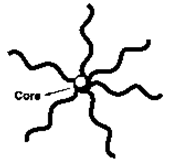This set of Organic Chemistry Multiple Choice Questions & Answers (MCQs) focuses on “Copolymerisation”.
1. Which of the following is true about copolymerisation?
a) radical, coordination, anionic, or cationic polymerization, depending on the type of initiation
b) addition of monomer to a metal complex, propagation is by successive insertion of monomer at the metal, and termination occurs when the metal complex separates from the polymer
c) monomers react by eliminating small molecules like H2O, NH3, CH2O and NaCl in a repetitive manner, Indefinite growth of the polymer occurs at both ends
d) a mixture of more than one (or different) monomeric species is allowed to polymerize
View Answer
Explanation: When two or more different monomers unite together to polymerize, the product is called a copolymer and the process is called copolymerization. If M and N are present together, Random type MM MN NNN MM N M MM N N…… and Alternating type M N M N M N M N M ………
2. Gradient copolymer comers under which of the following copolymer category?
a) Linked copolymer
b) Branched copolymer
c) Terepolymer
d) Brush copolymer
View Answer
Explanation: Linear copolymers consist of a single main chain and gradient copolymers are single chain of polymer in which the monomer composition changes gradually along the chain.
3. Which of the following copolymers is the copolymer with regular alternating A and B units?
a) Alternating copolymer
b) Periodic copolymer
c) Statistical copolymer
d) Block copolymer
View Answer
Explanation: Alternating copolymers are with regular alternating A and B units, as shown below. This sequence will not change.
—- A-B-A-B-A-B-A-B-A-B-A-B-A-B-A-B-A-B—-
4. Which of the following copolymers is the copolymer with A and B units arranged in a repeating sequence?
a) Alternating copolymer
b) Periodic copolymer
c) Statistical copolymer
d) Block copolymer
View Answer
Explanation: Copolymers with A and B units arranged in a repeating sequence are periodic polymers as shown below. This sequence will repeat itself to form a polymer.
(A-B-A-B-B-A-A-A-A-B-B-B)n
5. Which of the following copolymers is the copolymer with sequence of monomer residues follows a statistical rule?
a) Alternating copolymer
b) Periodic copolymer
c) Statistical copolymer
d) Block copolymer
View Answer
Explanation: Copolymers with sequence of monomer residues follows a statistical rule, are called as statistical copolymer, as shown in below. This sequence will not change.
—- A-B-B-B-A-B-A-B-A-B-A-A-B-B-B-A-A-B—-
6. Which of the following copolymers is the copolymer which comprises two or more homopolymer subunits linked by covalent bonds?
a) Alternating copolymer
b) Periodic copolymer
c) Statistical copolymer
d) Block copolymer
View Answer
Explanation: Copolymers which comprises two or more homopolymer subunits linked by covalent bonds, are called as block copolymer, as shown in below. This sequence will not change.
—- B-B-B-B-B-A-A-A-A-A-B-B-B-B-B—-
7. Which of the following copolymers is the copolymer in which the main chain is formed from one type of monomer A and branches are formed from another monomer B?
a) Terepolymer copolymer
b) Graft copolymer
c) Statistical copolymer
d) Star copolymer
View Answer
Explanation: Copolymers in which the main chain is formed from one type of monomer A and branches are formed from another monomer B, are called as graft copolymer, as shown in below. This sequence will not change.

8. Which of the following copolymers is the copolymer with several polymer chains connected to a central core?
a) Terepolymer copolymer
b) Graft copolymer
c) Statistical copolymer
d) Star copolymer
View Answer
Explanation: Copolymers with several polymer chains connected to a central core, are called as star copolymer as it is in star shape, as shown in below. This sequence will not change.

9. Which of the following copolymers is the copolymer consisting of three distinct monomers?
a) Terepolymer copolymer
b) Graft copolymer
c) Statistical copolymer
d) Star copolymer
View Answer
Explanation: Copolymers copolymer consisting of three distinct monomers, are called as terepolymer copolymer as it is in star shape, as shown in below. This sequence will not change.

10. Which of the following is the condition for ideal copolymerization?
a) r1r2=1
b) r1r2=0
c) r1=r2
d) r1=1
View Answer
Explanation: The composition and structural type of the copolymer depend on the reactivity ratios r1 and r2 according to the Mayo–Lewis equation also called the copolymerization equation.
Ideal copolymerisation happens when chain radicals have equal preference to add one of the monomers over the other.
Sanfoundry Global Education & Learning Series – Organic Chemistry.
To practice all areas of Organic Chemistry, here is complete set of 1000+ Multiple Choice Questions and Answers.
If you find a mistake in question / option / answer, kindly take a screenshot and email to [email protected]
- Check Chemical Engineering Books
- Check Organic Chemistry Books
- Apply for Chemical Engineering Internship
- Practice Chemical Engineering MCQs
